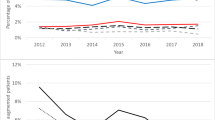Abstract
Introduction and hypothesis
Women have a lifetime risk of undergoing pelvic organ prolapse (POP) surgery of 11–19%. Traditional native tissue repairs are associated with reoperation rates of approximately 11% after 20 years. Surgery with mesh augmentation was introduced to improve anatomic outcomes. However, the use of synthetic meshes in urogynaecological procedures has been scrutinised by the US Food and Drug Administration (FDA) and by the European Commission (SCENIHR). We aimed to review trends in pelvic organ prolapse (POP) surgery in England.
Methods
Data were collected from the national hospital episode statistics database. Procedure and interventions-4 character tables were used to quantify POP operations. Annual reports from 2005 to 2016 were considered.
Results
The total number of POP procedures increased from 2005, reaching a peak in 2014 (N = 29,228). With regard to vaginal prolapse, native tissue repairs represented more than 90% of the procedures, whereas surgical meshes were considered in a few selected cases. The number of sacrospinous ligament fixations (SSLFs) grew more than 3 times over the years, whereas sacrocolpopexy remained stable. To treat vault prolapse, transvaginal surgical meshes have been progressively abandoned. We also noted a steady increase in uterine-sparing, and obliterative procedures.
Conclusions
Following FDA and SCENIHR warnings, a positive trend for meshes has only been seen in uterine-sparing surgery. Native tissue repairs constitute the vast majority of POP operations. SSLFs have been increasingly performed to achieve apical support. Urogynaecologists’ training should take into account shifts in surgical practice.







Similar content being viewed by others
References
Handa VL, Garrett E, Hendrix S, Gold E, Robbins J. Progression and remission of pelvic organ prolapse: a longitudinal study of menopausal women. Am J Obstet Gynecol. 2004;190(1):27–32.
Smith FJ, Holman CD, Moorin RE, Tsokos N. Lifetime risk of undergoing surgery for pelvic organ prolapse. Obstet Gynecol. 2010;116(5):1096–100.
Lowenstein E, Moller LA, Laigaard J, Gimbel H. Reoperation for pelvic organ prolapse: a Danish cohort study with 15–20 years' follow-up. Int Urogynecol J. 2018;29(1):119–24.
Maher C, Feiner B, Baessler K, Schmid C. Surgical management of pelvic organ prolapse in women. Cochrane Database Syst Rev. 2013;4:CD004014.
Maher C, Feiner B, Baessler K, Christmann-Schmid C, Haya N, Brown J. Surgery for women with anterior compartment prolapse. Cochrane Database Syst Rev. 2016;11:CD004014.
Gutman RE. Does the uterus need to be removed to correct uterovaginal prolapse? Curr Opin Obstet Gynecol. 2016;28(5):435–40.
Jha S, Cutner A, Moran P. The UK National Prolapse Survey: 10 years on. Int Urogynecol J. 2017;29(6):795–801.
Burns EM, Rigby E, Mamidanna R, Bottle A, Aylin P, Ziprin P, et al. Systematic review of discharge coding accuracy. J Public Health (Oxf). 2012;34(1):138–48.
Withington J, Hirji S, Sahai A. The changing face of urinary continence surgery in England: a perspective from the hospital episode statistics database. BJU Int. 2014;114(2):268–77.
Gibson W, Wagg A. Are older women more likely to receive surgical treatment for stress urinary incontinence since the introduction of the mid-urethral sling? An examination of hospital episode statistics data. BJOG. 2016;123(8):1386–92.
NHS Digital. Retrospective Review of Surgery for Urogynaecological Prolapse and Stress Urinary Incontinence using Tape or Mesh 2018 [Available from: https://digital.nhs.uk/data-and-information/publications/statistical/mesh/apr08-mar17/retrospective-review-of-surgery-for-vaginal-prolapse-and-stress-urinary-incontinence-using-tape-or-mesh-copy#key-facts.
Mascarenhas T, Mascarenhas-Saraiva M Jr, Ricon-Ferraz A, Nogueira P, Lopes F, Freitas A. Pelvic organ prolapse surgical management in Portugal and FDA safety communication have an impact on vaginal mesh. Int Urogynecol J. 2015;26(1):113–22.
Kurkijarvi K, Aaltonen R, Gissler M, Makinen J. Pelvic organ prolapse surgery in Finland from 1987 to 2009: a national register based study. Eur J Obstet Gynecol Reprod Biol. 2017;214:71–7.
Skoczylas LC, Turner LC, Wang L, Winger DG, Shepherd JP. Changes in prolapse surgery trends relative to FDA notifications regarding vaginal mesh. Int Urogynecol J. 2014;25(4):471–7.
Younger A, Rac G, Clemens JQ, Kobashi K, Khan A, Nitti V, et al. Pelvic organ prolapse surgery in academic female pelvic medicine and reconstructive surgery urology practice in the setting of the food and drug administration public health notifications. Urology. 2016;91:46–51.
Notten KJ, Essers BA, Weemhoff M, Rutten AG, Donners JJ, van Gestel I, et al. Do patients prefer mesh or anterior colporrhaphy for primary correction of anterior vaginal wall prolapse: a labelled discrete choice experiment. BJOG. 2015;122(6):873–80.
DeLancey JO. Anatomic aspects of vaginal eversion after hysterectomy. Am J Obstet Gynecol. 1992;166(6 Pt 1):1717–24. discussion 24–8
Paz-Levy D, Yohay D, Neymeyer J, Hizkiyahu R, Weintraub AY. Native tissue repair for central compartment prolapse: a narrative review. Int Urogynecol J. 2017;28(2):181–9.
Mowat A, Wong V, Goh J, Krause H, Pelecanos A, Higgs P. A descriptive study on the efficacy and complications of the Capio (Boston Scientific) suturing device for sacrospinous ligament fixation. Aust N Z J Obstet Gynaecol. 2018;58(1):119–24.
Wu JM, Hundley AF, Fulton RG, Myers ER. Forecasting the prevalence of pelvic floor disorders in U.S. women: 2010 to 2050. Obstet Gynecol. 2009;114(6):1278–83.
Korbly NB, Kassis NC, Good MM, Richardson ML, Book NM, Yip S, et al. Patient preferences for uterine preservation and hysterectomy in women with pelvic organ prolapse. Am J Obstet Gynecol. 2013;209(5):470.e1–6.
Detollenaere RJ, den Boon J, Stekelenburg J, IntHout J, Vierhout ME, Kluivers KB, et al. Sacrospinous hysteropexy versus vaginal hysterectomy with suspension of the uterosacral ligaments in women with uterine prolapse stage 2 or higher: multicentre randomised non-inferiority trial. BMJ. 2015;351:h3717.
Moen MD, Richter HE. Vaginal hysterectomy: past, present, and future. Int Urogynecol J. 2014;25(9):1161–5.
Author information
Authors and Affiliations
Corresponding author
Ethics declarations
Conflicts of interest
Martino Zacche does not have any conflict of interest. Sambit Mukhopadhyay accepted travel expenses from Dynamesh, Astellas, Kebomed UK, Cook Medical. Ilias Giarenis received speaker honoraria from Astellas.
Rights and permissions
About this article
Cite this article
Zacche, M.M., Mukhopadhyay, S. & Giarenis, I. Trends in prolapse surgery in England. Int Urogynecol J 29, 1689–1695 (2018). https://doi.org/10.1007/s00192-018-3731-2
Received:
Accepted:
Published:
Issue Date:
DOI: https://doi.org/10.1007/s00192-018-3731-2




